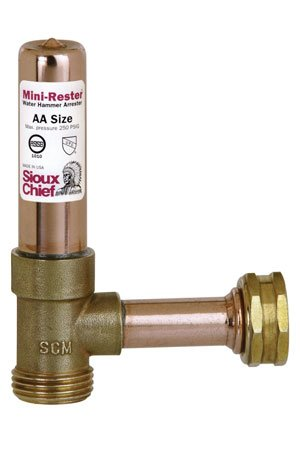Are you hearing loud noises in the pipes? Water hammer may be the cause. Here’s how to stop this racket and protect your pipes.
Q: Whenever the water in my washing machine fills up and the agitation cycle starts, I hear a series of loud noises coming from the pipes behind the wall. What could be causing this? Could it be damaging the pipes?
A: The “banging” sound is called “water hammer” and is a water hammer phenomenon that occurs when the shut-off valve in the high-pressure water piping suddenly closes. When you fill your washing machine with water, the water moves rapidly through your home’s plumbing, and when the washing machine drum reaches capacity, the valve suddenly closes. With nowhere to go, the water hits the side of the pipe under extreme pressure and just misses the wall frame and other pipes. As a result, you may hear a series of loud noises and feel your house shake under the pressure.
In addition to noise, water hammer can damage pipe connections and seams, causing leaks and costly repairs. Worse yet, the noise could be a signal of a larger problem, such as excessive pressure in the water pipes or loose pipes. Fortunately, water hammer can often be removed inexpensively at home without professional help. Follow these steps to investigate the problem yourself
Troubleshoot the plumbing air chamber to reduce water hammer.
This vertical pipe near the faucet helps mitigate the effects of water hammer by acting as a buffer. When the valve is closed, the air chamber absorbs the impact of the water and prevents the water from hitting the sides of the pipe too hard. In many homes, air chambers are installed in the walls, but they may not function well when water enters.
To solve this problem, the homeowner must drain the water from the pipes. Turn off the main water valve, open the highest faucet in the house, and drain the water from the lowest faucet (usually in the basement or on the first floor).
The air chamber will fill with air, not water, and is expected to solve the water hammer problem. If your home does not have an air chamber, consider having a professional contractor install one.
Waterhammer suppressors can also be installed to eliminate knocking noises.

A water hammer suppressor consists of an air-filled cylinder that absorbs the shock of the sudden increase in water pressure when the valve is closed.
Many water hammer suppressors are easy to install today and have a threaded connector between the water supply line and the shut-off valve (check Amazon for examples).
You should install two of these, one on the hot water line and one on the water supply line. However, if you are not familiar with basic plumbing connections, do not hesitate to call a plumber to install the shut-off valves.
Adjust the water pressure reducing valve.
Water hammer can occur if the water pressure in the piping is too high, in which case draining the air chamber or installing a water shutoff plate will only temporarily remedy the problem.
To adjust the pressure, the household pressure reducing valve must be adjusted. Most homes now have such valves installed at the main water supply entrance to the home.
Depending on the manufacturer, some valves have handles for adjustment, while others require a wrench or screwdriver. With proper technique, the valve is adjusted to 50 PSI (pounds per square inch) or less, which is an appropriate setting for most homes.
In addition, lowering the water pressure in the home may save energy, promote water conservation, and extend the life of vending machines (including expensive investment equipment such as washing machines, toilets, and dishwashers).
Reduce excessive water pressure at the water meter.
If your home does not have a pressure reducing valve, consider asking the municipality that manages your local water system to check your home’s water pressure. Municipal water systems typically keep water in the pipes at about 200 PSI, but residential plumbing is not designed to safely handle such high pressures. The municipality can usually check the water pressure for free and lower it if necessary.
Stabilize loose water pipes to prevent hammering.
When building a home, plumbers use U-shaped pipe straps to screw water pipes to wooden joists or studs. If these straps are not tight enough, or if several straps are missing, the pipe may knock and make noise.
To prevent this noise, tighten loose pipe straps with a screwdriver, or add more straps for added stability. Most pipe straps are molded from thin metal or plastic, but padded pipe straps are also available to further reduce vibration.
Homeowners should remember not to use galvanized or steel straps on copper pipes, as the combination of materials can lead to electrolysis and plumbing leaks.
Protect water supply lines with pipe insulators.
Pipe insulators are sold as foam tubing and are designed to fit around water pipes to prevent freezing. However, they also work well to cushion loose, bumpy pipes.
Foam pipe is pre-slit end-to-end, so you simply run your fingers along the slit to open the pipe and attach it to the water supply line.
Foam pipe insulation like this is usually sold in six-foot lengths for about $3 to $8 per pipe, depending on the density.










